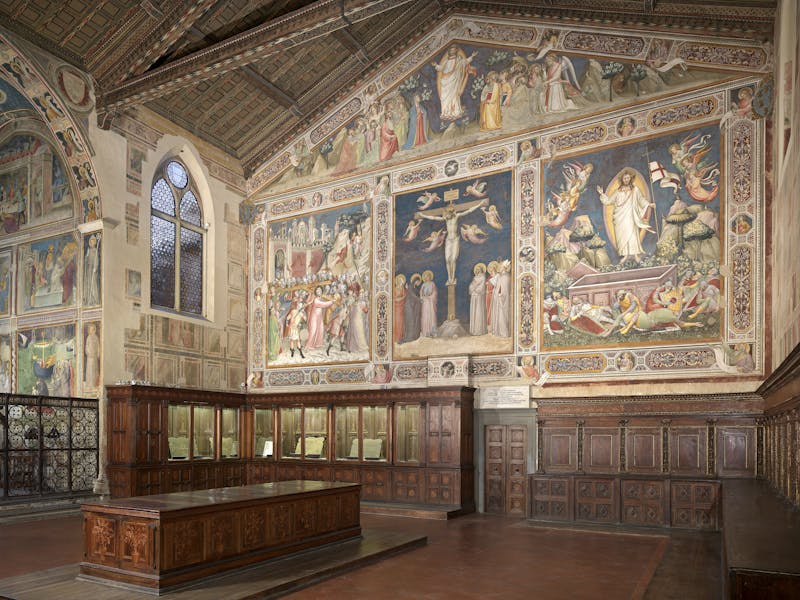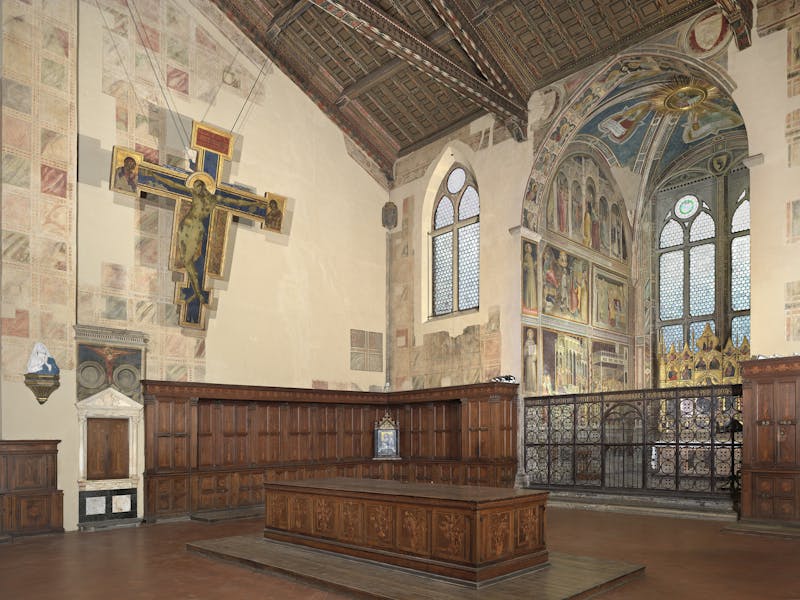
Sacristy
A sacristy is a room adjacent to a church or chapel where items used in liturgical services are stored and where the priest and other members of the clergy prepare for those services.
The sacristy in Santa Croce is a large rectangular room with a ceiling made of painted trusses. Its patrons are traditionally thought to have been the Peruzzi, whose coat-of-arms can be seen in the four corners of the room. It is one of the earliest examples of a monumental sacristy in Florence and its size is probably due to its original function as the chapter house, where the religious community would meet during the day and to discuss important business and where it was customary to read out a chapter of the Rule or Holy Scripture, whence its name. In the 15th century the monastery's chapter house was moved to the Pazzi Chapel.
The room is decorated with painted imitation marble panels and niches with saints attributed by scholars to Jacopo del Casentino.
When construction got under way on the Rinuccini Chapel in the mid-14th century, this led to the destruction of part of the frescoes painted on the east wall a few years earlier and thought to have contained a depiction of the Crucifixion.
That probably explains why the subject was painted again on the south wall, but this time by Taddeo Gaddi, and more scenes were added towards the end of the 14th century when Spinello Aretino painted the Procession to Calvary on the left and Niccolò di Pietro Gerini painted the Resurrection on the right and the Ascension above.

Interior of the Sacristy
Like most of the complex, the sacristy too has seen change over the years. A spectacular cupboard decorated with Stories from the Life of Christ and Stories from the Life of St. Francis, painted by Taddeo Gaddi between 1335 and 1358, was dismantled in 1810. Its 28 panels are currently divided between the Alte Pinakothek in Munich, the Gemäldegalerie in Berlin and the Galleria dell’Accademia in Florence which owns 25 of them.
The shape of the windows has also been changed over the centuries, while the ceiling and marble panels were once painted over in a yellowish tinge. The room was restored in its entirety, in an effort to "recapture its former character", by a group of craftsmen and painters under the guiding hand of architect Luigi Del Moro between 1884 and 1885.
Cimabue's Crucifix was moved here and hung very high up, fitting perfectly into its surroundings, in 2013 as part of a preemptive conservation programme designed and implemented by the Opera di Santa Croce to forestall the risk of flooding.

The sacristy owes part of its charm to its antique furniture consisting of a central chest and side cupboards dating back to the 15th and 16th centuries (with later alterations). Today as then, this furniture is used to store the vestments which the friars don here before attending liturgical services.